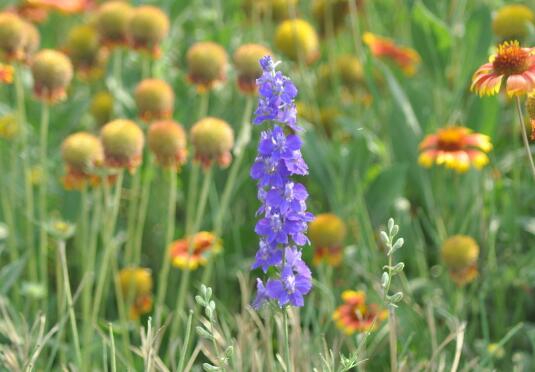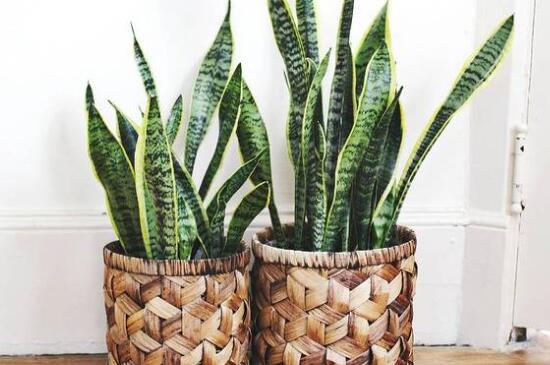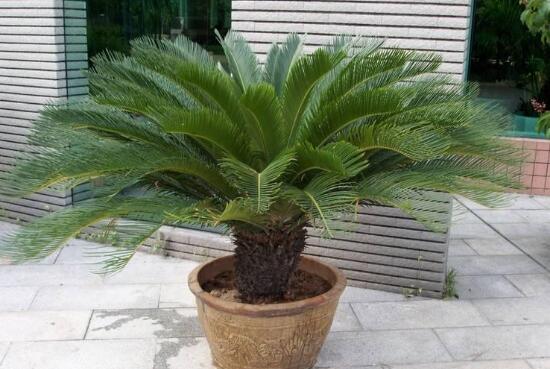How to raise sage, sage cultivation methods and precautions/plenty of sunshine
Sage is a kind of flower plant native to southern Europe and Mediterranean coastal areas, and then introduced to China. Nowadays, there are many people raising it in our country, but it is not an easy thing to raise it well, and there are many places that need to pay attention to. About how to raise sage? What are the breeding methods and matters needing attention of sage? Next, the editor will take you to learn about it.
First, how to raise sage and understand its habits

If we want to know how to raise sage, we must first understand its growth habits. this plant likes an environment with plenty of light and good ventilation, so we should keep enough light and ventilation when we breed it, so that it can grow more healthily.
2. Culture methods and matters needing attention of sage
1. Soil, neutral or slightly alkaline
Before we cultivate sage, we first need to choose the soil. Only if we let it grow in the right soil, it will grow better. Generally, it is best to choose loose and fertile neutral or slightly alkaline soil, so that the drainage of the soil will be better, but also can better absorb nutrients.
two。 Temperature, 20-25 ℃
It is necessary to maintain a certain growth temperature during the growth period of sage, which should not be too high or too low. If the temperature is too low, the leaves of sage will turn yellow, and if the temperature is too high, the leaflets of sage flowers will be small, and the plant will grow poorly or even stagnate. Its suitable temperature is between 20-25 ℃. We can pay attention to it when we breed it.
3. Fertilizing, liquid fertilizer once every half a month
Fertilizer is one of the main nutrients in the growth process of sage, especially after entering the growth period, its demand for fertilizer is very high, and it needs to be fertilized once in less than half a month. in the choice of fertilizer, we can choose ammonium sulfate diluted 1500 times, do not apply urea at low temperature.
4. Moisture, avoid stagnant water
Watering is an indispensable part of the growth of sage, but it has different needs for water according to different climates. if it is a dry climate, we should water it frequently, and in the season, we should drain water in time to avoid stagnant water.
5. Light, avoid strong light
Sage prefers a sunny environment, and only with sufficient light can it grow well, so we can put it outside all day to receive light when the light is more suitable in spring and autumn, but when the light is strong in summer, we still need shade to avoid strong light to burn the plant.
6. Trim, pick out the heart
In order to make sage grow better, we have to prune its heart regularly during its growth, which can promote the development of new branches, and we have to prune its flower branches after sage blossoms. so it will blossom again in autumn.
7. Timely treatment of diseases and insect pests
When we breed sage, if we are not careful enough, it is easy to let diseases and insect pests enter while we are not careful. this kind of problem is very harmful to the plant, and we must deal with it in time when it is found. the specific treatment methods are introduced in detail in the article on the prevention and control of diseases and insect pests of sage, which you can understand.
What's the difference between sage and rosemary? Culture methods and matters needing attention of sage
[FAQ] what's the difference between sage and rosemary? How to raise sage?
[expert answers]
I. the difference between sage and rosemary
1. Differences between families and genera: although sage and rosemary both belong to angiosperm phylum and dicotyledonous class, they are very different after subdivision. Sage belongs to the aromatic plant of sage with petal subclass, while rosemary belongs to rosemary shrub of chrysanthemum subclass.
two。 Morphological differences: sage is shrubby, relatively short, leaves oval, hairy, gray-green or white-green, verticillium purple, pink or white, flowers with irritating aroma, early flowering. Rosemary has higher plant type, dark gray stem, hairy young branches, from four-prism to cylindrical in the process of growing into old branches, leaves clustered, short stalked or sessile, flowers opposite, flowering later.
Picture: sage
3. Difference of origin: according to the different growth habits of sage and rosemary, their growth areas are also very different. In China, sage is generally distributed along and south of the Yangtze River, except for plateaus and basins, while rosemary can also be planted in Shandong as an cash crop.
4. Difference of medicinal value: sage as a herb, its main effects include clearing heat and detoxification, promoting blood circulation and removing blood stasis, reducing swelling and regulating menstruation, etc., mainly for jaundice, dysentery, sore dampness-heat, falling injury and so on. It is also traditionally used for hospital disinfection. The main medicinal function of rosemary is to calm the mind and awaken the brain, mainly for insomnia, headache, palpitation and so on.
2. Culture methods and matters needing attention of sage
1. Potted soil selection: cultured sage can be transplanted to the pot when it grows to a certain extent, usually when the plant has 2 Murray 3 leaves. It should be noted that sage likes alkaline soil, calcareous soil is more suitable, but ordinary garden soil is also possible, you can choose loose, breathable soil, mixed with some compound fertilizer as base fertilizer.
two。 Light and temperature: sage likes to grow in a warm environment and requires sufficient light to grow well. Basically, sage needs to be given plenty of light, but shade is needed in the summer, and more light is needed during sage seedlings to avoid overgrowth. It is necessary to maintain a certain growth temperature during the growth period of sage, not too high or too low. If the temperature is too low, the leaves of sage will turn yellow, and if the temperature is too high, the leaflets of sage flowers will be small, and the plant will grow poorly or even stagnate.
3. Watering and fertilization: sage likes a drier climate, but it should not be too dry. Sage plants need to be watered when they are short of water. Of course, they should be drained in time in rainy seasons to avoid stagnant water. Fertilization should be reasonable, which is beneficial to the growth of sage plants. during the growth period, some thin liquid fertilizer can be applied, and some fertilizers rich in growth elements can be applied frequently.
Picture: sage
4. Propagation method: the reproduction of sage, including sowing propagation, cutting propagation and plant division propagation, the operation is relatively simple.
5. Diseases and insect pests: the common diseases and insect pests of sage are powdery mildew, stem rot, rust and leaf spot, mainly whitefly, shell insects, aphids and red spiders.
6. Pruning and heart-picking: basically, in order to make sage grow well, it is necessary to prune the heart frequently and promote new branches. And after the sage blossoms, the flower branches can be pruned in time at the end of August in summer, and can blossom again in autumn.
[editor's conclusion] sage and rosemary are both aromatic plants that can extract spices or essential oils. they look similar, but there are still many differences. The above not only introduces the difference between sage and rosemary, but also introduces the breeding methods and matters needing attention of sage. I hope it can be helpful to everyone!
Culture methods and matters needing attention of Salvia officinalis
Latin name Saiviaofficinalis
Also known as perilla leaf
The plant kingdom.
Phylum angiosperm
Dicotyledonous class
Subclass chrysanthemum
Eye-labial order
Department of labiology
Subfamily wild sesame subfamily
Sage tribe
Belongs to sage.
Grow blue sage
Distributed in Zhejiang, southern Anhui, Jiangsu, Jiangxi, Hubei, Fujian, Taiwan, Guangdong, Guangxi.
Sage (Saiviaofficinalis), also known as Perilla, is a perennial plant of Labiatae, with well-developed roots, clustered aboveground parts, stems nearly woody, shorter, leaves opposite, gray and silver, oval serrated, petioles longer, densely covered with white villi, feel like velvet, basal leaves near petiole narrower, stem leaves longer and more pointed. It is very beautiful to have 6-10 flowers in a series of whorls on the top of the stem. The seed is nearly orchard-shaped, the weight of a thousand seeds is 4 grams, and the germination ability is more than 3 years. Adult plant height 80 cm, potted 30-50 cm, blue-purple to pink-purple flowers, fragrant, leaves have a strong fragrance. Flowers can be used to make tea, send out a clear fragrance can purify the body oil, help circulation, can play the effect of beauty.
1. Morphological characteristics.
The root system of sage is well developed, the aboveground parts are clustered, it is a perennial herb, the base of the stem is slightly Lignified, the plant height is 30-90 cm, short, the whole plant tissue contains volatile oil, with strong aroma and bitterness, slightly astringent taste. Stem tetragonal, more branched, hairy. Leaves opposite, gray and silver, long oval, apex round, 3-5 cm long, petiolate, entire or obtusely serrated, green, thick texture, foliage wrinkled, densely covered with white tomentose, feel like velvet, basal leaf near petiole narrower, stem leaf longer and more pointed. August flowering, lip-shaped flowers about 10 whorls, open at the top of the stem or leaf axils, flowers purple or cyan, sometimes white, Corolla lip-shaped. It is very beautiful to have 6-10 flowers in a series of whorls on the top of the stem. The seed is nearly orchard-shaped, the weight of a thousand seeds is 4 grams, and the germination ability is more than 3 years.
2. Growth environment
Sky blue sage likes a warm, sunny environment, cold-resistant and can withstand a low temperature of-15 ℃. It has strong drought tolerance. Like a slightly shaded and well-ventilated environment, the general soil can grow, but like the slightly alkaline calcareous soil with good drainage. Resistant to drought, but not resistant to waterlogging, especially like limestone-rich, or sandy, well-drained soil, annual cultivation in extremely cold areas.
3. Distribution
Domestic distribution: Zhejiang, southern Anhui, Jiangsu, Jiangxi, Hubei, Fujian, Taiwan, Guangdong, Guangxi; born on hillsides, roadsides, shady grass, watersides and shade, 220m above sea level. 1100 m.
Distribution abroad: also in Japan. The type specimens were collected from Japan.
- Prev

What if Phnom Penh Tiger Pilan has no Phnom Penh? an Analysis of the reasons for the disappearance of Phnom Penh Tiger Pilan Phnom Penh
As a kind of tequila family, Phnom Penh tiger skin orchid friends should be no stranger, it is a variety of tiger skin orchid, its characteristic is that the leaf edge with gold edge, looks very beautiful. So when Phnom Penh Tiger Pilan Phnom Penh disappears, flower friends must be in a hurry! So, what if Phnom Penh Tiger Pilan has no Phnom Penh?
- Next

How to raise the iron tree, the cultivation methods and precautions / light of potted iron tree should be sufficient.
For the iron tree, flower friends should have heard of it, its beautiful tree shape, green leaves, evergreen four seasons, is a widely acclaimed foliage plant. In life, because the iron tree is very effective, so many people want to raise a pot at home, how to raise the iron tree? To this
Related
- Fuxing push coffee new agricultural production and marketing class: lack of small-scale processing plants
- Jujube rice field leisure farm deep ploughing Yilan for five years to create a space for organic food and play
- Nongyu Farm-A trial of organic papaya for brave women with advanced technology
- Four points for attention in the prevention and control of diseases and insect pests of edible fungi
- How to add nutrient solution to Edible Fungi
- Is there any good way to control edible fungus mites?
- Open Inoculation Technology of Edible Fungi
- Is there any clever way to use fertilizer for edible fungus in winter?
- What agents are used to kill the pathogens of edible fungi in the mushroom shed?
- Rapid drying of Edible Fungi

